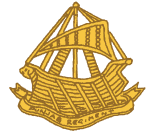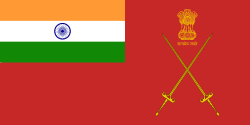Punjab Regiment (India)
| The Punjab Regiment | |
|---|---|
|
Regimental Insignia of the Punjab Regiment | |
| Active | 1761 – Present |
| Country |
|
| Branch | Indian Army |
| Type | Line Infantry |
| Size | 19 Battalions |
| Regimental Centre | Ramgarh Cantonment, Jharkhand |
| Motto(s) | Sthal Wa Jal (By Land and Sea) |
| War Cry |
Jo Bole So Nihal, Sat Sri Akal (He who cries God is Truth, is Ever Happy) (Sikh) Bol Jawala Ma Ki Jai (Victory to Goddess Jawala) (Dogra) |
| Decorations |
• Padma Bhushan- 02 |
| Battle honours |
Post Independence Zojila, Icchogil, Dograi, Burki, Kalidhar, Bedori, Nangi Tekri, Brachil Pass, Longewala and Garibpur |
| Commanders | |
| Colonel of the Regiment | Lt Gen R R Nimborkar, AVSM VSM SM** |
| Insignia | |
| Regimental Insignia | A Galley with a bank of oars and sail |
_by_A_C_Lovett.jpg)
The Punjab Regiment of India was formed from the 2nd Punjab Regiment of the British Indian Army in 1947. It is one of the oldest regiments still in service in the Indian Army and has taken part in various battles and wars winning numerous honors for the same. It is one of the most acclaimed regiments of the Indian Army.
Prior to independence and partition there were a number of "Punjab regiments" in the British India. These were amalgamated to form six regiments: the 1st Punjab Regiment, the 2nd Punjab Regiment, the 8th Punjab Regiment, the 14th Punjab Regiment, the 15th Punjab Regiment and the 16th Punjab Regiment. At the onset of independence in 1947, the 1st, 8th, 14th, 15th and 16th Punjab Regiment went over to the newly raised Pakistan army, while the 2nd Punjab Regiment was retained in the Indian Army. Troops were transferred between regiments based on whether the soldiers would be a part of Pakistan or India.
Organizational History
The Punjab Regiment is one of the oldest in the Indian Army. The first battalion which today constitutes this regiment was raised in 1805. This was done by the then Maharaja of Patiala. The first four British-raised battalions of what later became the 2nd Punjab Regiment and finally the Punjab Regiment, were raised during the hostilities in the Carnatic in South India between 1761 and 1776. (Note – The 15 Punjab only became a battalion of the regiment after Independence). The first and second battalions have been converted to other regiments and the fourth battalion was disbanded. The third battalion still continues as part of the regiment. The numbers and titles of the battalions changed during the successive reorganisations of the Madras Presidency Army, the British Indian Army and the Indian Army during the 18th, 19th and 20th Centuries. The names changed from Coast Sepoys to Carnatic Infantry, Madras Native Infantry, Punjabis and finally to the Punjab Regiment. After 1857, the British applied the Martial Races theory and north Indian troops replaced the South Indians, the regiment eventually being renamed as The Punjab Regiment.
The 1st Battalion of the 2nd Punjab Regiment (now the Punjab Regiment of the Indian Army) initially formed part of the 44 (later 2nd) Indian Airborne Division in an airborne role on the disbandment of the Indian Parachute Regiment in 1946 and was called 1st Bn, 2nd Punjab Regt (Para). The unit retained Punjab Regiment uniform except donning the maroon beret, qualification wings and allied insignias of the airborne. In 1952, when the Parachute Regiment was raised and a Regimental Centre formed, 1st Punjab, became the 1st Bn of the Parachute Regiment and known as the 1st Battalion, the Parachute Regiment (Punjab). The uniform changed to the Parachute Regiment but retained the Punjab's hackle on its headgear.
In 1951, four battle experienced battalions of the former princely states of Punjab, joined the Regiment. These were a battalion each from the Jind and Nabha State Forces and the First and Second Battalions of Patiala Infantry (as mentioned above). They are now designated as the 13, 14, 15 and 16 PUNJAB. Additional battalions were raised since 1963.
15 Punjab
Fifteen Punjab (Formerly First Patiala), is one of the finest units of Indian Army, completed 300 years of service to the nation on April 13, 2005. Currently deployed somewhere in the western sector, the battalion was raised on the auspicious baisakhi day in 1705 by Baba Alla Singh, the founder of Patiala State. It was the first battalion of the state forces of the Maharaja of Patiala. Apart from being the oldest infantry battalion in the Indian Army, 15 Punjab also has the proud distinction of being the second highest decorated battalion of the Army, with 22 Battle Honours, one Theatre Honour (Punjab) and numerous gallantry awards. The battalion took part in numerous campaigns in India and abroad, carving a mark for itself in every operation. In May 1900, the battalion was re-designated as First Patiala Imperial Service Infantry (Rajindra Sikh). During World War-I, it took part in operations in the Middle East under the British Expeditionary Force. In 1932, the battalion was re-designated as First Patiala Rajindra Sikh Infantry. During World War-II, the battalion participated in the Burma Campaign. It successfully cut off the Japanese lines of communication, thus halting their advance towards India. Thereafter, the battalion sailed to Port Dickson for action in Malaya and Batavia (now Java).[1] 15 Punjab regiment is considered to be the bravest regiment in India . with senior officers served for the special Lebanon mission of UNO (united nations organization), Capt. Avtar singh Gill led the party in Sudan and Major Surinder Singh Dhaliwal served as the chief of their mission in Lebanon . They are some of the most respected ambassadors of Indian govt. for UNO.
2 Punjab
The 2 Punjab (now First Battalion, the Brigade of the Guards) was raised in 1762 as the tenth battalion of the Coastal Sepoys and has been redesignated eighteen times since then. The troop composition of the unit was changed to a North Zone Battalion in 1902 and the unit was redesignated as 69 Punjab. In 1922, the unit was redesignated as 2/2 Punjab Regiment. The battalion, by virtue of its seniority and efficiency, was handpicked by the then Chief of the Army Staff, Gen (later Field Marshal) KM Carriappa to be redesignated as First Guards in April 1951. Lt Col (later Brigadier) Shivinder Singh was the first commanding officer of the battalion. Since then, 22 commanding officers had commanded the battalion and brought it to the present state of glory. Of them, Lt Col MCS Menon, Lt Col Sehdev Sahgal and Lt Col PP Singh retired as Generals.
UN Peacekeeping Operations
In recent years, the Punjab Regiment has contributed towards UN peacekeeping missions by sending three of its battalions overseas i.e. in Gaza, Angola and Lebanon (3,14 and 15 PUNJAB respectively).
Regimental Centre
The Regimental Centre was first raised at Loralai and was shifted to Multan in 1922, Meerut in 1929 and its present location in Ramgharh, Jharkhand in 1976.
Battalions
- 3rd Battalion
- 9th Battalion
- 13th Battalion - (former Jind Infantry) - Princely State Forces unit of Imperial Service Troops
- 14th Battalion - (former Nabha Akal Infantry) - Princely State Forces unit of Imperial Service Troops
- 15th Battalion - (former 1st Patiala Rajinder Sikh Infantry) - Princely State Forces unit of Imperial Service Troops
- 16th Battalion - (former 2nd Patiala Yadvinder Infantry) - Princely State Forces unit of Imperial Service Troops
- 17th Battalion
- 18th Battalion
- 19th Battalion
- 20th Battalion
- 21st Battalion
- 22nd Battalion
- 23rd Battalion
- 24th Battalion
- 25th Battalion
- 26th Battalion
- 27th Battalion
- 28th Battalion
- 29th Battalion
- 102nd Infantry Battalion (Territorial Army) Punjab
- 150th Infantry Battalion (Territorial Army) Punjab
- 156th Infantry Battalion (Territorial Army) (H&H) Punjab
- 7th Battalion Rashtriya Rifles Punjab
- 22nd Battalion Rashtriya Rifles Punjab
- 37th Battalion Rashtriya Rifles Punjab
- 53rd Battalion Rashtriya Rifles Punjab
Apart from the above battalions, the following were also affiliated to the Regiment at one time or the other.
- 1st Battalion – 1 Para (Special Forces)
- 2nd Battalion – 1 Guards (Mechanized)
- 4th Battalion – Disbanded in 1938
- 7th Battalion – 8th Mechanised Infantry
- 8th Battalion – Disbanded after World War II
- 10th Battalion – Regimental Centre
The regiment has an affiliation with INS Ranjit (D53), a Rajput class destroyer of the Indian Navy.
Class Composition
The original battalions of the regiment that were transferred to India after 1947 were composed primarily of Sikh and Dogra soldiers who belonged to the districts of Punjab that were given to Pakistan. However the second and third generations for the regiment were recruited both among this refugee community but recruitment was opened up to all castes and communities of Punjab, Jammu and Kashmir and Himachal Pradesh in the late 1960s. The regiment currently consists of Dogras and Sikhs[1] primarily drawn from North Indian states of Jammu and Kashmir, Himachal Pradesh and Punjab. However, as an exception, two regular battalions (19 and 27 PUNJAB) have troops from other Indian castes as well.
Key Battles
Battle of Longewala
During the Indo-Pakistan War of 1971, 'A' company (reinforced), 23rd battalion, the Punjab regiment, with about 120 soldiers, fought off an assault by a brigade of the Pakistan Army. The battle was fought at the desert border post of Longewala. The unit fought during the last three hours of the night of December 5, 1971 unsupported as the Indian Air Force aircraft did not have night attack capabilities. The company commander, Major (later Brigadier) Kuldip Singh Chandpuri, was decorated with the Maha Vir Chakra, the second highest gallantry award in India.
Regimental Insignia
The regiment is perhaps the only infantry regiment with naval Galley as an insignia, anywhere. It was awarded to 69th Punjabis (later 2nd PUNJAB) in recognition of the readiness to serve overseas, after the battalion had fought in eight overseas campaigns by 1824.
Battle honours
Pre-Independence
Sholinghur, Carnatic, Mysore, Mehidpore, Ava, China, Pegu, Lucknow, Burma, Afghanistan, Laos, Flanders, Hellis, Krithia, Gallipoli, Suez, Egypt, Sharon, Nablus, Palestine, Aden, Kut-al-Amara, Baghdad, Mesopotamia, North Western Frontier, Mersa Metruh, Buthidaung, Ngakyedauk Pass, Imphal, Kangla Tongbi, Tonzang, Kennedy Peak, Meiktila, pyinmana, Malaya, Ipoh, Singapore, Kern and Casa Bettini.
Post-Independence
Zoji La, Ichhogil, Dograi, Barki, Kalidhar, Bedori, Nangi Tekri, Brachil Pass, Laungewala, Garibpur,Chak Amaru and Jessore[2]
In fiction
- Films
- Border, a 1997 Bollywood film directed by J.P.Dutta, depicts the Battle of Longewala.
- Lakshya, a 2004 Bollywood film depicting the Kargil War, places the protagonist (played by Hrithik Roshan) as an acting captain in 3 Punjab.
References
- 1 2 John Pike. "Punjab Regiment". Globalsecurity.org. Retrieved 2014-02-15.
- ↑ Archived June 19, 2009, at the Wayback Machine.

